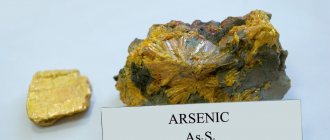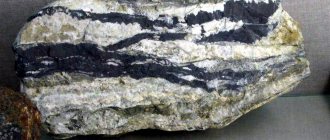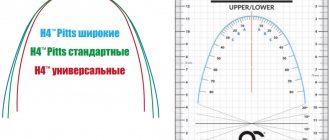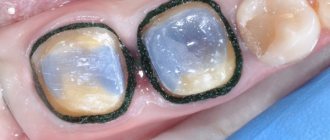Randol (beryllium bronze) is an alloy of copper with beryllium (BeCu), and sometimes other alloying elements. The chemical composition is 97% copper and 0.5 to 3% beryllium. Externally it resembles gold. Randol is also called “gypsy” or “samovar” gold, as the alloy was often used to make counterfeit jewelry.
Beryllium bronze was discovered by the American company Little Falls Alloys Corp in 1943. Since its commercial introduction, it has been used for the production of spring wire.
The alloy combines high strength (not inferior to many types of steel), non-magnetic properties, elasticity, corrosion resistance, good electrical (slightly inferior to copper) and thermal conductivity, as well as low plastic deformation. Randole lends itself well to cold drawing, is quite plastic, can be easily machined and formed, and is used for the manufacture of special metalworking tools used in explosive environments (there is no sparking during impacts), as well as musical instruments, precision measuring devices, bullets and aerospace instruments.
Randole can be forged, welded and cut, and is resistant to non-oxidizing acids (for example, hydrochloric or carbon), plastic decomposition products, as well as abrasive wear and abrasion. The alloy can be heat treated to improve strength, toughness and electrical conductivity. Thus, randole achieves the highest strength among all other copper alloys.
Beryllium bronze is produced in the form of round, square, flat or shaped wire in coils, coils and straight sections.
What is Randol and what is its composition?
Wikipedia explains the term "Randole" as a technical concept from the metallurgical field. This is an aluminum billet that is used in the further production of aerosol cylinders. However, there is another explanation. Randole is one of the varieties of non-ferrous metals that is obtained artificially. In appearance, the material resembles gold, but it is not.
Aluminum tube billet
Scope of application
Having such unique properties, randol is often used in the most unusual pieces of equipment. As already mentioned, randole is used in the electrical industry. Bronze elements of relays and contact group assemblies, springs and clamps, without all this it would be impossible to electrify and ensure the normal functioning of entire regions.
For railways, beryllium bronze is a truly strategic resource - from wheel bearings to electrical components of electric locomotives and switches, randol is needed everywhere.
Modern shipbuilding is impossible without the use of randol. At the same time, not only civilian, but also military, especially for the nuclear fleet. Many parts of power plants of surface and underwater ships are equipped with randolium pipelines, and the housings of sensors and instruments are made of metal. After all, metal is not only difficult to machine, it does not oxidize and is not subject to aging, which is very important in such conditions.
Beryllium bronze is the main material for the manufacture of drilling tools. It is the randole that is used as a head into which diamonds are inserted for drilling deep wells.
Randole is often used in medicine - dentures are made from it. And although not all artificial teeth made of bronze survive, temporary crowns are made from it.
About composition and application
Randol in Wikipedia is designated as a blank for the production of tubes. But experts give this term a clearer explanation. Randol is an alloy of copper and beryllium. The gypsies use the resulting material to make beautiful jewelry, shown in the photo.
Randole jewelry
In industry, Randol is used for the manufacture of:
The Randol composition, due to the inclusion of beryllium, exhibits high wear-resistant qualities. The material is not magnetic and does not spark in the event of impacts. The alloy is resistant to heat and is therefore used in pipeline construction. Gypsy gold is highly durable. It is used in drilling rigs. Randol metal passes through any deposits in the earth's crust without breaking or undergoing deformation.
It is interesting that if Randoli contains more than 3% beryllium, such an alloy loses its qualities. The metal becomes brittle and unsuitable for industrial use. Experts say that an alloy consisting of 98% copper and 2% beryllium is ideal in terms of quality and strength.
Stylish randole jewelry
Today, more than 30,000 tons of Randoli are produced annually in the world. The price of metal ranges from 500 to 1000 rubles per 500 grams. Randol is supplied to production in ingots, strips, tapes, granules, and rods. For a certain industry, magnesium, nickel or titanium is added to the alloy. In rare cases, lead is added to the Randol alloy, but in very small quantities. Lead makes metal easier to cut.
Randol metal. Properties of randol. Application of randoli
Properties of randoli
The tensile strength of randol is higher than that of most alloyed steels. It is an alloy of copper with the addition of beryllium.
The latter requires only 1.3 percent. Externally, the combination resembles gold, which is why it is often called that way with the prefix “gypsy”.
The nomadic people adapted to making jewelry from the alloy and selling them, passing them off as precious.
randol its main, and, most importantly, legal application in industry. It has a unique property.
All alloys “age.” Over time, their strength decreases. With beryl bronze the opposite is true.
The material only becomes “steadier” over the years. This quality of the alloy is used in the aviation industry.
A large passenger liner contains at least a thousand randoll items .
Consumers of the mixture of copper and beryllium are the automotive industry and the electrical engineering industry.
Randol alloy is used for springs, springs, shock absorbers, bearings and more.
The anti-magnetic, wear-resistant properties of bronze come in handy. In addition, the material does not spark when struck.
The alloy with beryllium is resistant to heat, therefore it is used in sliding bearings. These are pipeline elements.
It supports the segments in a vertical plane. The element is movable. It rubs against adjacent metal parts, heating up.
If there were another alloy in place of beryl bronze, neighboring elements would begin to penetrate each other and grind down.
Gypsy gold is a material for drilling rigs. Randol allows them to “bite into” any rock of the earth’s crust without deforming or breaking.
Randol , composition is filled with beryllium by more than 3 percent, loses its unique properties.
For the same reason, pure beryllium is not used. It is incredibly hard, but brittle.
Metal can break when dropped, even though it cuts steel. If there is an excess of alloying element in the randol, the alloy also becomes brittle.
The ideal balance is achieved with 88 percent copper and 2 percent beryllium. In its pure form it cannot be processed and is not plastic.
Bronze with it can be drawn into wire one tenth of a millimeter thick.
The volume of global consumption of beryl bronzes is 30 thousand tons per year. These are the data of the analytical agency Roskill.
Randoli price
For randol alloy, the price is 500-550 rubles for the same number of grams of gypsy gold. This is the lower threshold.
Some manufacturers charge more than a thousand rubles for just 100 grams of metal.
Randol is most often supplied in rods and granules. There are also ingots, strips, and strips.
The alloy markings should be clarified. In the classic version there are only two metals. However, there are samples, for example, with a small admixture of titanium.
They are used in the aircraft industry. There are combinations with nickel or magnesium. The price tag for it also depends on their presence in the alloy.
The rarest mixture contains 0.4 percent lead. The additive improves the properties of metal during cutting.
This is the process of removing small chips from the surface of an alloy. This is necessary to give the semi-finished product the desired shape. The technology is reminiscent of processing wood with a plane.
Randoli production
The standards for the production of domestic and foreign beryl bronzes vary.
Only semi-finished products produced by the Moscow Non-Ferrous Metals Processing Plant meet international criteria.
The remaining Russian enterprises are still operating according to GOST 1789-70 approved in the USSR.
It provides only two states of the alloy - soft and hard. European manufacturers divide randoli according to the degree of deformation after hardening.
There are indicators from 11 to 16 percent, from 21 to 26, and 29 percent. For comparison, domestic hard beryl bronzes, designated by the letter “H,” are deformed by 30, 40 percent. Soft samples (letter “A”) do not change at all.
Deformation increases the strength of the alloy. It is carried out after hardening, that is, strong heating followed by sharp cooling.
The properties of bronze improve only if it is changed in a cooled state.
on the degree of this change, and hence the final strength of the randole .
Application of randoli
Consumers do not want to overpay for an alloy with 40% indicators if they are not purchasing it for nuclear reactors and missiles.
Jewelry made from randole alloy , for example, does not need to be deformed. A soft composition is suitable for jewelry making.
Gypsy gold is widely used in the production of costume jewelry, watch bracelets, and decorative items.
The yellow metal is used to make pen bodies, cigarette cases, and knife blades. Randol is even used for dental crowns.
True, they are called prison ones because such “implants” are used in prison zones.
Prisoners are treated free of charge; it is not profitable to give them crowns made from more expensive materials.
Randole teeth often do not take root and cause allergic reactions, but prison inmates have nowhere to go.
Beryllium teeth, however, like other parts of the body, are not offended by the statues. Bronze is a classic material for them.
In cases where it is necessary to create the effect of a gold composition, beryl alloy is used. Badges and medals are also made from it.
They do not fade over time, unlike products made from other types of bronze. They even make coins from randol, although only decorative ones.
You cannot pay in such monetary units. Gypsy gold is identical in appearance to the 375 standard of real gold. That is, the alloy has a pronounced pink, reddish tint.
Jewelers note that the casting of the randole products themselves is more complex than those made of precious metal. Therefore, only experienced craftsmen work with special bronze.
Randol in jewelry
Surely each of us has heard the term “gypsy gold”. What it is? This is the second name for Randoli. Considering that this alloy is very similar in appearance to gold, nomadic people make jewelry from it. They cannot be called jewelry, since the composition of these products does not include expensive materials.
But still, gold randol is used for making:
Moreover, in prison clinics Randol is used to make crowns. And although such elements do not take root and often cause allergic reactions, prisoners have to agree to their installation.
Where else is Randol alloy used? This metal is used to make decorative coins, badges, and medals. In appearance, the mixture of copper and beryllium resembles 375 gold metal. However, according to experienced jewelers, it is more difficult to make jewelry from it than from precious material.
Why is randole called “gypsy gold”
Products made from a mixture of beryllium and copper are similar in appearance to gold, so large earrings, rings, and necklaces, traditionally worn by the gypsy people, were sold at fairs under the guise of jewelry.
Such jewelry has a right to exist, like any other jewelry, but the buyer must be warned about what he is actually buying.
Unfortunately, beryllium bronze was often sold as gold, which it has nothing to do with.
Therefore, the price of gypsy gold should be lower than the cost of the original precious metal.
Moreover, the gypsies learned to make even cheaper analogues, replacing beryllium with chromium or nickel. Such jewelry sparkled only at first, but then quickly faded and oxidized.
Second gold
In conditions of the economic crisis, many people purchase products from the so-called second gold. What it is? It is an alloy of Randoli and brass. Thanks to its attractive appearance, the material perfectly imitates gold, which is confirmed by the photo. Only a jeweler can distinguish an alloy from a real precious metal. Products made from this material are practically resistant to oxidation and rust.
Second gold has the following advantages:
Women really like the second gold. After all, purchasing products does not require a lot of money, and the result is amazing.
Biological moment
Often after having their ears pierced, women tend to immediately put on gold earrings. But if there are none, you can replace them with randoli earrings. Thanks to the special composition, products made from second gold are hypoallergenic. That is, when wearing earrings made of second gold, you don’t have to worry that your earlobes will swell and suppuration will appear. Gold jewelry does not cause negative side effects.
How to distinguish randole from gold
There are several ways that allow you to understand that what you have in front of you is a painted alloy or gold. Of course, the most reliable way is to shop in trusted jewelry stores, where you can be sure of the quality of the jewelry.
How can you verify the authenticity of a product without special equipment?
Check the sample
First of all, find a print that shows the percentage of pure precious metal in the alloy. The most common standard is 585, the highest is 999 (this is bank metal, not jewelry). You can use a magnifying glass to examine the mark.
Inspect the joints
If you have a chain or bracelet in front of you, look at the joints. There is usually a slight difference between the color of the metal and the joint: when soldering gold, jewelers use a higher grade metal at the joint because it melts easily.
Randall properties:
– similar in color and shine to gold,
– high strength (not inferior to many types of steel),
– not magnetic,
– no sparking during impacts,
– perfectly amenable to machining and welding,
– does not pose a health hazard. However, inhalation of alloy dust and fumes can lead to adverse effects,
- does not age. Over time it becomes more durable, unlike other alloys,
– heat resistant
– plastic,
– high corrosion resistance,
– good electrical conductivity (slightly inferior to copper),
– good thermal conductivity,
– low plastic deformation.
Note: © Photo https://www.pexels.com, https://pixabay.com
Randol Wikipedia gold composition brass photo medical rings alloy products teeth price per gram buy 3mm wire how much does jewelry cost melting point
World economy
Directories
In-demand technologies
Search for technologies
What is this site about?
This site is dedicated to the author's scientific developments in the field of economics and the scientific idea of implementing the Second Industrialization of Russia.
It includes: - the economy of the Second Industrialization of Russia, - the theory, methodology and tools of innovative development - the implementation of the Second Industrialization of Russia, - the organizational mechanism for the implementation of the Second Industrialization of Russia, - a directory of breakthrough technologies.
Using Randall
In manufacturing, randole is used to make springs, spring wires, load cells and other structural elements that must maintain their shape during periods of cyclic compression and extension. All alloys “age” and their strength decreases. But beryllium bronze, on the contrary, becomes more durable over the years. This quality of the alloy is valued by aircraft manufacturers: there are at least a thousand randoll products in a passenger airliner.
Randol is also in demand in the automotive industry, where springs, shock absorbers, bearings and much more are made from it.
The alloy's electrical conductivity allows it to be used in low-voltage battery contacts and electrical connectors.
The lack of sparking on impacts, combined with its strength, allows the randole to be used for the manufacture of bench tools that can be safely used in environments containing explosive vapors and gases, for example, on drilling rigs and in coal mines: screwdrivers, pliers, wrenches, chisels, hammers and etc. Randol tools are more expensive and less wear-resistant than steel ones. But these disadvantages of the alloy are more than compensated by its safety in explosive environments.
“Gypsy gold” is widely used in the production of costume jewelry, decorative items and accessories. The yellow metal is used to make pen bodies, cigarette cases, knife blades, and even dental crowns.
Randol alloy price
To understand why a gram of alloy has such a price, you need to understand what the metal is intended for. Scrap metal as part of jewelry or leftover equipment will be inexpensive, usually buyers give 40-60 rubles per gram for it, it depends on the amount of metal. When purchasing metal in the form of industrial blanks, it can cost about 400-500 rubles per 1 gram of metal. For jewelry workshops, the alloy is offered in rods, ingots, plates and granules for remelting. The price of such metal is about 700 rubles per gram. It’s easy to find out how much metal for dentistry costs - the price starts from 1000 rubles.
The price of Randol is 400-500 rubles per 1 gram of metal
The most expensive is randol containing lead - this bronze not only lends itself well to machining, it is also excellent for forging. The price of such metal starts from 1,500 rubles per gram.
Unfortunately, the production of beryllium bronzes in Russia today does not meet international standards. In the country, only the Moscow Nonferrous Metal Plant produces products that meet some international standards for beryllium bronze.











